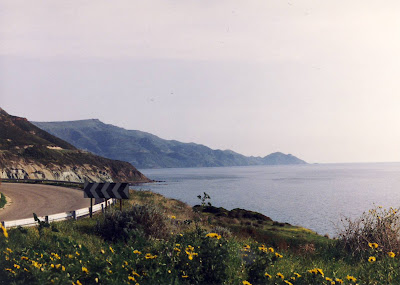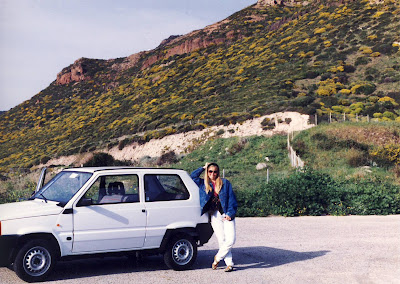Limestone Coast, South Australia, south of Adelaide, at dusk, when the big red kangaroos appear as shadows along the sides of the road.

Federal, Wyoming, northwest of Cheyenne, either under the blackest sky punctured by millions of bright white stars, or under a blue sky arching over windswept high plains.
West coast of Sardinia, south of Alghero, on a road hugging a cliff that rises over the Mediterranean, a million shades of blue.
These three places have one thing in common: silence. A silence I've never heard anywhere else. A silence so complete that the slightest noise -- distant mooing, a train rumbling in its approach, a tiny bell on the collar of a goat, respectively -- becomes an indelible memory. There are many things I remember from each of the vacations that took me to these places, but rising to the top of the stack is an unearthly silence, broken in each place by a faint sound that captures the activity, movement and day-to-day life of the place.
In the case of Sardinia, that tiny goat-bell came to epitomize the wonderful trip I took to visit Sister there in 1994. We had rented a Fiat Panda and were driving from Cagliari to Alghero.
Somewhere along that road we had to stop as an old man herded his goats across the thoroughfare, from the cliff-side of the road across to where his modest house sat. It was quiet. All we heard was that tinkling bell, tied around one of the goat's necks. It was late afternoon and Sister and I theorized that the man was eager to herd his goats back home so that he could go inside and enjoy whatever it was his wife had cooked for him that night.
Maybe she made him malloreddus. Maybe fregula. Maybe something with bottarga. Or some music bread. Sardinian cuisine is unique, informed by centuries of isolation, a shepherding culture that flourished inland despite a magnificent fish-rich island coastline (thousands of years of raids from outside civilizations will do that to a people) and ancient recipes that have not changed in generations and that reflect completely the Sardinian experience but only vaguely recall the mainland Italian one.
A flip through Efisio Farris' excellent book, Sweet Myrtle and Bitter Honey: The Mediterranean Flavors of Sardinia, will teach you all about Sardinian cuisine filtered through his own experience of family and hospitality. It's a charming book, full of charming recipes. Like "the pasta of the cattleman," found on page 134, a simple dish of penne, fresh tomatoes, fresh cheese and herbs.
The old Sardinian man with the goats was, by all empirical evidence, a goat herder, not a cattleman. But maybe his wife made him the pasta of the cattleman that night in 1994 anyway. I like to imagine she did.
++++++
THE PASTA OF THE CATTLEMAN (MACARRONES DE MASSAJU)
Adapted slightly from Sweet Myrtle and Bitter Honey, by Efisio Farris
By way of context, Efisio has the following to say about the pasta of the cattleman: "Massaja vona si viet I' su pacu!" say the men of Sardinia: literally, "A capable woman is revealed when using very little." Growing up, we often did not have a lot, and with the men away for days at a time working, bartering, or tending to the fields, women ran every part of the home. They took care of the finances, watched over the children, cooked the meals, and everything in between. In other words, they did a lot with a little. Mannai Carta could make dinner with one egg and a little fresh cheese and make my grandfather happy. The cattleman's wife would do the same with his ingredients in this recipe, including making the fresh cheese from a bucket of milk he brought to her."
1 lb. penne pasta
1/4 c. extra-virgin olive oil
4 garlic cloves, thinly sliced
6 Roma tomatoes, peeled, drained, seeded and cut into 1/2-inch strips
1 T. fresh flat-leaf parsley, chopped
Sea salt
6 oz. fresh mozzarella cheese, cubed
3 sprigs basil, chopped
Cook the pasta in salted boiling water until al dente.
Heat the olive oil in a large skillet over medium heat. Add the garlic and cook until golden.
Add the tomatoes and parsley.
Add the cooked pasta and salt to taste and toss well.
Place the pasta in a serving bowl and toss with the fresh mozzarella and basil.
Makes 4 servings.









3 comments:
I'm growing Roma tomato plants and basil in my garden right now--I'm going to make this with my first harvest since I know I'll want something simple to savor the flavor of my crop.
I loved your whole article. When I was little we lived in the sage country that runs through Idaho and Wyoming and I remember the silence.
Great post. Now you have me wondering where I have been that it was super quiet. The Aran Islands in Ireland were pretty darn quiet, but I don't know if they were totally silent. The jungle (Khao Sok if I am remembering the name right) in Thailand, likewise.
Maybe it is because I am more visual, but what knocks me out in these super silent places is usually the number of stars I can see.
Melanie, this would absolutely be a great dish to showcase your delicious homegrown produce -- there's not much there to mask the fresh, amazing flavors of the vegetables and herbs. And I'm glad you know what I mean about the silence...it is really memorable.
Laura, thank you! It sounds like you've been to some amazing places. Generally the way I operate is, the more remote and desolate, the better. I LOVE places where I feel like I'm at the end of the earth.
Post a Comment